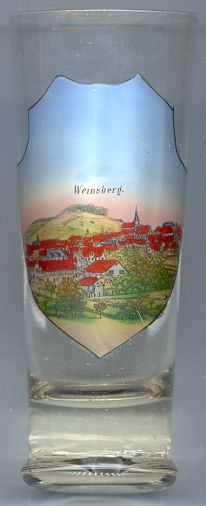

|
| DEUTSCHLAND | GERMANY |
| Bundesland: Baden-Württemberg | |
| Regierungsbezirk: Stuttgart | |
| Landkreis: Heilbronn |
 Weinsberg is situated at an elevation of 219 m in the Weinsberg valley at the Saubach stream, a tributary
of the river Sulm in northern Baden-Württemberg.
Weinsberg is situated at an elevation of 219 m in the Weinsberg valley at the Saubach stream, a tributary
of the river Sulm in northern Baden-Württemberg.
Archaeological finds demonstrate the presence of Celtic tribes in the 2nd century BC. The first regular settlements, however, seemed to have been set up by the Romans in the 2nd century AD. This settlement was destroyed by the Alemanni about one century later. Around 500 the Alemanni were replaced by the Franks. The earliest written mention of the Sulmanachgowe (Sulmgau) region is found in a document of 778. Weinsberg castle was founded around 1000 as an Imperial fortress guarding the trading route from Heilbronn to Schwäbisch Hall.
The town Weinsberg proper was founded around 1200 at the foot of the castle at the site of an existing market place at the trading route. The first mention of Weinsberg dates from 1241. The document lists the tributes of towns that were in possession of the Hohenstaufen dynasty. In this list Weinsberg comes in 29th place, paying tributes to those of Donauwörth, Wiesbaden, Offenburg or Konstanz. It is not known when Weinsberg was chartered as a town, but it must have been pefore 1283, because in this year Löwenstein received a town charter based on that of Weinsberg. At first pne half of the town had the status of an Imperial city, the other was in possession of the Lords of Weinsberg residing in te castle. This situation caused repeated clashes between the town council and the lords. In 1417 the town lost its partial status of an Imperial city. The town sought to remain independent and thus joined the Weinsberg Union, a union of 33 Imperial cities which intended to protect the independence of Weinsberg. As a consequence, the Lord of Weinsberg reached a verdict of the German King (late Emperor) Sigismund of Luxembourg who outlawed the adult citizens of the town. A ban by Pope Martin V was issued in 1424, followed by a further ban by the king in 1425. The struggle for indepence continued until 1428 when an agreement was reached between the town and the lord of Weinsberg. Sigismund agreed two years later and thus confirmed the status of Weinsberg as an (undivided) Imperial city. However, Weinsberg lost this status already ten years later when it became part of the Palatinate. In 1450 the castle also was purchased by the Palatinate.
During the War of the Landshut Succession Weinsberg was conquered by Duke Ulrich of Württemberg, which was confirmed by the Treaty of Urach in 1512. Together with all of Württemberg, Weinsberg in 1520 became part of Austria for a period of fourteen years. During the Peasants' War of 1525 the town was conquered by the insurgent peasants who killed the bailiff of Weinsberg and his knights on Easter Sunday of that year ("Weinsberger Blut-Ostern"). After the town was retaken by the authorities, it was burnt down and was stripped of all its privileges. After the return of the Duke of Württemberg in 1534, Weinsberg again referred to itself as a town, although a new charter was formally awarded only in 1553.
During most of the 19th century a great number of the inhabitants of Weinsberg emigrated to North America. Only the industrialisation of the late 19th century improved the economic situation of the town. On the otherh and, Weinsberg also became known as the place of residence of the physician and poet Justinus Kerner who lived here from 1819 until his death in 1862. Kerner freqently invited poets into his house. Among his visitors were Ludwig Uhland, Gustav Schwab and Nikolaus Lenau, which earned Weinsberg the sobriquet "Swabian Weimar". Kerner also achieved to end the further destruction of Weinsberg castle, which by that time was already reduced to ruins.
In 1926 Weinsberg lost its status as seat of an administrative district. During World War II Weinsberg at first was left relatively untouched by the war activities so that it could take in refugees from nearby Heilbronn. However, a bomb rain on the 12th of April 1945 destroyed most of the historic town. The rebuilding of the town was essentially completed until 1955. The communities of Weinsberg, Eberstadt, Ellhofen and Lehrensteinsfeld joined the administrative union (Gemeindeverwaltungsverband) Raum Weinsberg in 1971. The communities of Grantschen and Gellmersbach were incorporated into Weinsberg in 1973 and 1975, respectively. Today, Weinsberg has a population of about 12,000 (2004).
Weinsberg, more precicely Weinsberg castle (castle Weibertreu), by popular tradition is connected with the legend of the "Faithful Women" (Treue Weiber). The story was first recorded in 1144 and 1175. Further important historic documents telling the story are a chronicle of 1500, and Philipp Melanchthon's 1516 edition of the "World Chronicle" of Johannes Nauclerus. Throughout history, the story was also told about other castles, but most frequently was located in Weinsberg. Jacob and Wilhelm Grimm included the story in the second book of "Deutsche Sagen", which made it very popular throughout Germany. In the most popular versions, the story plays in 1140 when the castle was besieged by the German King Konrad III. After the castle surrendered, the king promised free exit to the women and allowed them to take with them everything that they could carry on their back while the men were supposed to die. However, the women came down from the castle carrying on their back—their husbands, who were spared the death penalty since the king kept his promise.
![[scale]](lineal.jpg)